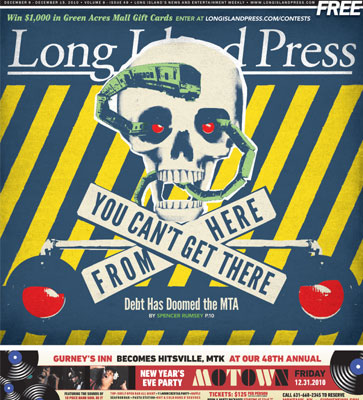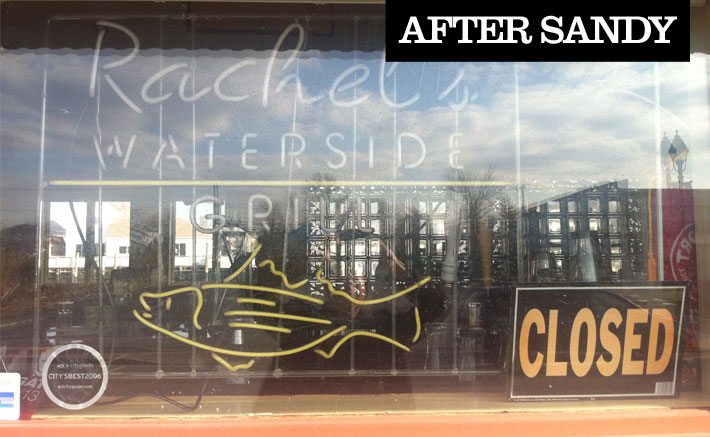
TRAIN IN VAIN
Under the LIRR’s current round of service cuts and fare hikes, says Michaels of the commuter council, “our highest paid, highest educated workers are really suffering.” Many riders are starting to reconsider why they bother to live on Long Island, she says. “You used to commute because of the experience of raising children in New York City, but it isn’t so tough there anymore.”
According to Michaels, LIRR riders “pay more than anybody in the MTA commuting community” to use the system, and the fares have reached the tipping point. “It is now cheaper for two people to drive in than it is for them to take the railroad,” she says.
“If you go from Huntington, right now it’s $25 roundtrip for peak,” Michaels says. “So you put two people together, that’s 50 bucks. But you can park in a lot of places in Manhattan for under $30 a day. That’s the point where there’s something seriously flawed.”
On Dec. 30, the MTA is raising fares again—the third time in three years. Tickets on the LIRR and Metro-North will increase by 7 percent to 14 percent, depending on the travel length. In the city, a one-way subway ride will cost $2.50; a 30-day MetroCard will cost $104.
Drivers in our region will be pinched, too. Tolls on the Verrazano-Narrows Bridge will rise from $11 to $13, quite a hike from the 50 cents toll when the bridge opened in 1964. Tolls are going up 18 percent on all the other MTA bridges and tunnels. This is the fifth MTA toll hike since 2003. Subway, bus and commuter railroad riders face the prospect of another fare hike next year.
“They put the MTA on the credit card back in 2002,” says Silverman, “and now we’re paying for it, and it was Albany that did that. Normally you have capital paid for by long-term bonds; you buy a train, and it pays for itself over 30 years. In the past they didn’t use the fare box. But now they did. This was a sea change in the way they financed capital.”
For Bear Sterns, the investment company that issued the new bonds almost a decade ago, it was very lucrative, reportedly netting them hundreds of millions of dollars in fees. But apparently the company didn’t sock it away for a rainy day because it didn’t have nearly enough to survive the onslaught of the Great Recession. Bear Sterns is now part of JPMorgan Chase. Interestingly, Robert Foran, the Bear Sterns municipal bond banker who oversaw the $15-billion debt restructuring, became Chairman Walder’s chief financial officer this spring. Whether the MTA is looking to float new bonds remains to be seen because its ability to borrow has already been affected by the bad economy, which lowered its rating.
“You cannot invest in capital without borrowing money, and to borrow money you have to have the means of repaying it, and that means a revenue source. You have fares, tolls and taxes. There’s no fairy godmother,” Lt. Gov. Ravitch tells the Press. He added that a more progressive income tax “would help.”
“Mass transit never pays its own way,” says Lee Koppelman, Long Island’s planner emeritus, who once was both the Suffolk County planning director and the Long Island regional planning director. “That’s why Robert Moses was absolutely death on mass transit. He didn’t want to have anything to do with it, and the same with the Port Authority, except for the airlines, if you consider them mass transit.”
Apparently New Jersey’s feisty new Republican governor, Chris Christie, doesn’t want to have much to do with mass transit, either. A decision Christie made in October to abandon his state’s commitment to fund its share of building a new Hudson River tunnel has sent ripples across the region. Even LIRR commuters are affected, though they probably don’t know it yet.
Christie claimed New Jersey couldn’t afford any cost overruns on the $8.7-billion Access to the Region’s Core project, aka ARC. Some transit advocates slammed him for bailing out long before the bill came due. The feds say the governor now owes them $271 million, a tab he’s trying to avoid by hiring a high-priced Washington, D.C.-based law firm, Patton Boggs, to fight it.
In theory, Christie’s welshing could free up $3 billion in federal funds, a sum not lost on Nassau and Suffolk county executives Ed Mangano and Steve Levy, who held a joint news conference at Farmingdale State College before Thanksgiving to make their pitch for the infrastructure money.
“We hope that New Jersey’s loss can be our gain,” Levy told the Press. So far, Transportation Secretary Ray LaHood hasn’t responded to Levy and Mangano’s request. Levy made it clear at the news conference he doesn’t want to take federal money from the MTA’s other worthy projects in New York City.
“We owe a debt of gratitude to Gov. Christie,” Michael White, executive director of Long Island Regional Planning Council says, “because at least that put some money back in the hopper that we might be able to grab onto for transit.”
Right now, 21 tracks at Penn Station have to handle Amtrak, LIRR and NJ Transit trains. A snafu with one can affect them all. When a NJ Transit train derailed on the Wednesday before Halloween, the LIRR had to cancel almost two dozen trains during the evening rush hour. A new Hudson tunnel would send NJ Transit riders to a new annex station nearby and thereby give LIRR commuters at Penn Station some much needed breathing room. But it is not to be.
LIRR riders have already felt the squeeze from construction underway on the Moynihan Station project to convert the old James Farley Post Office into a new Amtrak facility. Once Amtrak moves out by 2016, LIRR riders may have one less bottleneck to worry about.
“We’re spending a lot more building the East Side Access Project and we don’t have enough money to finish that,” says Ravitch. “That’s what the Long Island Rail Road rider ought to worry about.”
Despite a political shift in Congress following November’s election, Rep. King is confident that the East Side Acccess project will be completed by 2016 as planned. “Right now, it’s on target,” he says. But he’s less sanguine about the future.
“The main problem will be with new projects,” King says. “The money just isn’t there. The reality is we’re just going to have several years of real retrenchment.”
Chairman Walder tells the Press, “Both parties recognize the importance of mass transit!” He added, “The federal government’s support is essential to our region’s economy.” He doesn’t see that commitment wavering. “We’re a region that’s choking right now.”
But who will get us out of this stranglehold?






